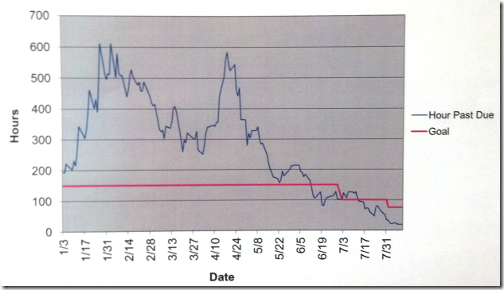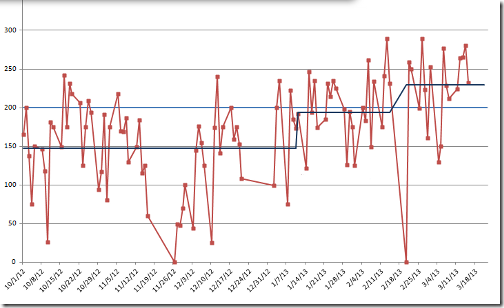Past Due Hours
This area was picked for the initial focus because they were way, way behind, and it was getting worse.
The initial work was done in mid-April. The target was consistent output at takt time.
As the team looked at the process, and identified the sources of disruption and variation, “changeovers” surfaced pretty quickly as a main issue.
“Which obstacle are you addressing now?” was the changeover times on the output process, so the target condition for the area’s team was to get the disruption to output for a change over down to a single takt time vs. the highly variable (up to 10 takt times or more) disruptions they were seeing.
One big mindset change was the concept of takt time. There was a lot of perceived variation in the run times of these parts. But upon study, the team realized the variation was a lot less than they thought. Yes, it is there, but over any given couple of hours, it all evens out most of the time.
As the team studied their changeovers, one of them had an insight that “We can do a lot of these things before we shut the machine down.” And in that moment, the team invented the SMED methodology of dividing “internal” and “external” changeover tasks.
Once that objective was grasped, they went to town, and saw lots of opportunities for getting most of the setup done while the last part was still running.
Their lot sizes were already quite small, the core issue here was the disruption of output caused by the increased tempo of changeovers. So that time was put back into capacity, resulting in the results you see above.
They continue to work on their changeover times, have steadily reduced the WIP between process stages, and (as you can see) keep outrunning their goals for “past due hours.”
But the really important bit here is that this was largely the team leaders, the supervisor, and the area manager. Yes, there was technical advice and some direction giving by the VP and the Continuous Improvement manager, but the heavy lifting was done by the people who do the work every day.
Consistent Output
This is from another company, in a completely different industry. Their issue, too, was that they were always behind. In this industry, the idea of a takt time is pretty alien. Even the idea of striving for a fixed level of output every day is pretty alien.
The team’s initial focus was maintenance time. They perceived that equipment reliability was causing them to fall behind in production, and so were shipping product to a sister plant every week to fill in the gaps.
The first question posed to them was “How much time is needed for production?”
In other words, they needed to figure out how much production time was “enough,” so they could then assess how much time maintenance could have. That would establish their target.
But in answering that question, they developed a takt time, then measured output cycles vs. that takt. What they saw was lots of inconsistency in the way the work was being done.
If they could hold to something close to their demonstrated lowest-repeatable cycle times, they could then know when they were “done” for a given shift, or day, and actually plan on maintenance time rather than seeing it as a disruption to production.
The focus shifted to the work cycles.
What is cool about this team is that the team leader / “learner” (in Toyota Kata terms) was the maintenance manager.
He gained a real shift in perspective. “Production” were no longer the people who wouldn’t let him maintain the machine, they were his customers, to whom maintenance needs to deliver a specified, targeted, level of availability as first priority.
The teamwork developed about the end of Day 2 of this intense learning week, and they have been going after “sources of variation” ever since.
Here is the result in terms of “daily output:”
As you can see, not only is the moving average increasing, but the range is tightening up as they continue to work on sources of variation.
The big downward spike on the right is two days of unplanned downtime. In retrospect, they learned two things from that.
- After foundering a bit, they applied the same PDCA discipline to their troubleshooting, and got to the issue pretty quickly. As a sub-bullet here, “What changed?” was a core question, and it turned out someone had known “what had changed” but hadn’t been consulted early on. Lesson learned – go to the actual place, talk to EVERYONE who is involved rather than relying on assumptions.
- Though they sent product out for processing, they realized they could have waited out the problem and caught up very quickly (with no customer impact) had they had more faith in their new process.
All pretty cool stuff.
These things are why this work is fun.


This is great stuff. Were these improvements a part of daily problem solving or a part of a Kaizen event? Was the testing done while production was running?
In the first case (“Hours Behind Schedule”) there was what would look like a kaizen event, but its purpose was to teach the shop leadership how to cycle through daily improvements. The participants were mostly the area manager, supervisor, team leaders. The initial work on changeover reduction was done there.
Following that, however, they continued daily problem solving. That is really where most of the gains were made. Eventually, they shifted their focus onto other parts of the process and continued to work.
We had a follow-on teaching event where we brought in the upstream loop in the value stream – the one that provided work orders and raw material to the primary value-adding process cell. That was also kick-started by the event, but continued (and continues) to improve, mainly by pulling kanbans out of the pipeline to surface the next level of obstacles. They have gone from struggling with 7 kanbans in circulation to running with 4. Prior to the initial work, there were dozens of orders in process in that part of the value stream, and lots of cherry picking. Now it all runs FIFO.
The FIFO, in turn, has forced the value-adding process to get even better at changeovers, as there is less and less opportunity to batch stuff up. That, in turn, provides more throughput.
In the “Consistent Output” case, there was also a kaizen event to kick-start the process of improvement.
In this case, the team started with tabletop simulations of the work flow. This was valuable because it is difficult to see the big picture in the actual work area. It also allowed very quick iterations of trying ideas. They used this, really, to develop a common understanding of what really happens, and to develop a pretty detailed target condition of how the process must operate if it is to achieve its output requirements.
Mid-week, they took that target condition to the shop floor, and that is when the kaizen cycles really began. They ran rapid PDCA cycles, learned very quickly what worked, what didn’t, and why. Though it was started during a kaizen event, the process continued, and still continues (it has been about 4 months as I write this) to identify issues, strive for consistent work flows, and develop more capacity.